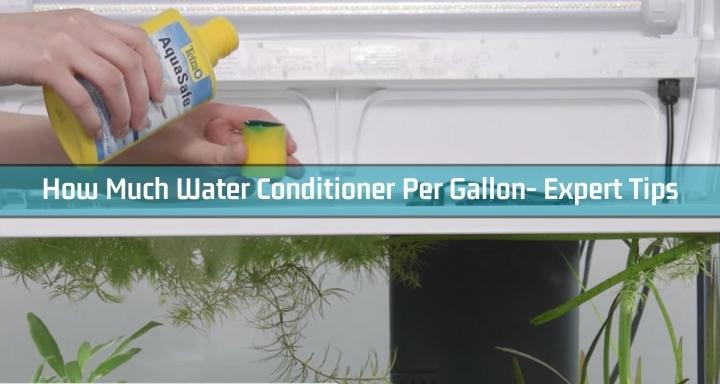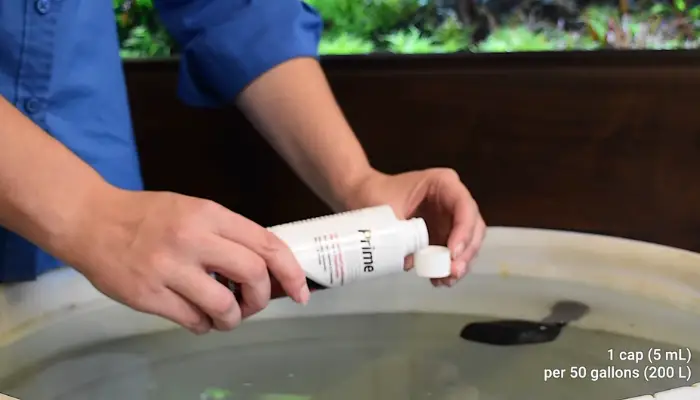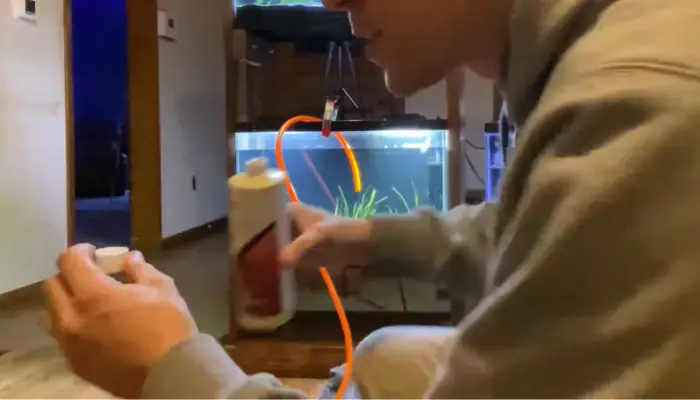
Last week, one of my friends came to me with a problem related to the estimation of water conditioner per gallon. He didn’t know about the importance of water conditioners in aquariums. I suggested that to him.
But unfortunately, he applied a higher dose than necessary which created a lot of problems in his aquarium. That’s why I would like to describe the ways of estimating the water conditioner per gallon so that you can not make such a fault.
Also, I will explain the ways to recover from the mistake if you do it unfortunately. And, I explained the importance of adding a water conditioner to my friend. So, stay tuned with me.
How Much Water Conditioner Per Gallon For A Fish Tank

Before adding water conditioner, you have to know the perfect amount of water conditioner that is to be added to your tank. The dosage of water conditioner for a fish tank typically depends on the specific product you are using, as different brands and formulations may have further instructions.
It’s important to read and follow the instructions provided on the packaging of the water conditioner you have. However, as a general guideline, most water conditioners are dosed at a rate of 1 teaspoon (about 5 milliliters) per 10 gallons of water. So if you have a 20-gallon fish tank, you would use 2 teaspoons (about 10 milliliters) of water conditioner.
Here is the water conditioner dosage for different tank sizes-
| Tank Size (Gallons) | Water Conditioner Amount (Teaspoons) | Water Conditioner Amount (Milliliters) |
|---|---|---|
| 2 | 0.2 | 1 |
| 2.5 | 0.25 | 1.25 |
| 3 | 0.3 | 1.5 |
| 5 | 0.5 | 2.5 |
| 10 | 1 | 5 |
| 15 | 1.5 | 7.5 |
| 20 | 2 | 10 |
| 40 | 4 | 20 |
It’s important to remember that the measurements I provided are approximate and might not be the same for every water conditioner out there. So, what you really need to do is take a look at the instructions on the packaging of the water conditioner you have. They’ll give you the exact dosage you should be using.
Here is the water conditioner dosage for 10 gallon aquarium- Comparing Different Brands
| Water Conditioner | Dosage per 10 Gallons (ml) | Dosage per 10 Gallons (tbsp) |
|---|---|---|
| Tap Fin water conditioner | 5 ml | 1 tsp |
| Tap water conditioner | 0.5 ml | 0.1 tsp |
| API water conditioner | 0.5 ml | 0.1 tsp |
| API STRESS COAT | 5 ml | 1 tsp |
| Glofish water conditioner | 5 ml | 1 tsp |
| Aqueon water conditioner | 5 ml | 1 tsp |
| Fluval water conditioner | 5 ml | 1 tsp |
| Tetra AquaSafe Plus Aquarium Water Conditioner | 5 ml | 1 tsp |
| Aquatic Experts TankFirst Complete Water Conditioner | Follow package instructions | Follow package instructions |
| Seachem Prime Fresh and Saltwater Conditioner | 2 ml | 0.4 tsp |
| Jungle Start Right Complete Water Conditioner | Follow package instructions | Follow package instructions |
| Fritz Aquatics Complete Water Conditioner | 1 ml | 0.2 tsp |
| Brightwell Aquatics Blackwater Water Conditioner | Follow package instructions | Follow package instructions |
How To Understand How Much Water Conditioner Is Per Gallon?

If you are not experienced in aquarium-keeping, this question may bother you about how to understand how much water conditioner to use per gallon of water. Sometimes, experts also get confused in this case. However, let me suggest you.
To understand this, you need to refer to the instructions provided by the specific brand and product of the water conditioner you are using. The instructions on the product packaging will usually provide guidelines on the recommended dosage based on the volume of water you want to treat.
In general, most water conditioner products will provide a recommended dosage in terms of drops, teaspoons, or milliliters per gallon. Check some general steps that will help you to understand how much water conditioner to use per gallon.
Read The Instructions
First of all, carefully read the label or packaging of the water conditioner product you have. You can look for the section that provides directions or dosing instructions.
Check The Recommended Dosage
Next, you have to find the recommended dosage of the water conditioner per gallon of water. It may be listed as drops, teaspoons, or milliliters. You can choose any of them according to your convenience.
Measure The Water
After that, try to determine the volume of water you want to treat. If you’re using a gallon-sized container, then it’s easy. But if you have a different-sized container, make sure to adjust the dosage accordingly.
Calculate The Amount
Following that, use the recommended dosage information to calculate how much water conditioner you need. For example, if the recommended dosage is 1 teaspoon per gallon and you have 5 gallons of water, you would multiply 1 teaspoon by 5 to get the total amount needed.
Add The Conditioner
Finally, add the calculated amount of water conditioner to the water you want to treat. Follow any additional instructions provided, such as stirring or shaking the mixture.
Remember that these steps are general guidelines, and it’s crucial to follow the specific instructions provided by the manufacturer of your water conditioner. If you have any doubts or questions, it’s always a good idea to reach out to the manufacturer or consult with a knowledgeable professional.
Why Do You Need to Measure the Amount of Conditioner?
You have learned the way of measurement. But are you thinking about how this knowledge will help you in your aquarium? Hence, let me explain. Measuring the amount of conditioner in a fish tank is important for maintaining a healthy aquatic environment for the fish.
Conditioners, such as water conditioners or dechlorinators, are commonly used in fish tanks to neutralize harmful chemicals, such as chlorine or chloramine, that are often found in tap water. To make it more clear, let me include some specific points.
Chlorine And Chloramine Removal
Tap water is treated with chlorine or chloramine to kill bacteria and make it safe for human consumption. However, these chemicals can be harmful to fish. Conditioners help to neutralize chlorine and chloramine by chemically binding to them or breaking them down into harmless substances.
It is crucial to measure the correct amount of conditioner to ensure that all the harmful chemicals are adequately removed.
Fish Health
Chlorine and chloramine can stress fish, damage their gills, and compromise their immune system. If not properly treated, these chemicals can lead to fish illness or even death. By measuring the appropriate amount of conditioner, you can effectively detoxify the water and provide a safe environment for your fish.
Consistency And Accuracy
Measuring the conditioner ensures that you are adding the right dosage to your tank consistently. Overdosing or underdosing can have negative consequences.
Adding too much conditioner can harm fish and other aquatic organisms while adding too little might not effectively remove the harmful chemicals from the water. Measuring the correct amount helps maintain a stable and healthy environment for your fish.
Water Quality Control
Monitoring the amount of conditioner added to the fish tank allows you to maintain proper water quality. Conditioners not only remove chlorine and chloramine but also often contain additional substances.
It can help in improving the overall water quality by neutralizing heavy metals or detoxifying ammonia. By measuring the conditioner, you can ensure the water parameters are within the appropriate range for your fish.
Why Do Water Conditioners Use?
Removing Hardness
The first activity of a water conditioner is to remove hardness caused by minerals such as calcium and magnesium. Hard water can leave mineral deposits on the surfaces of the aquarium.
Water conditioners use ion exchange or other methods to remove these minerals, resulting in softer water and creating a better environment for the fish.
Reducing Chlorine and Chemicals
Water conditioners can also remove chlorine and other chemicals from water. Chlorine is commonly added as a disinfectant, but it can affect the odor of water.
Water conditioners with activated carbon filters can effectively remove chlorine and improve the smell and overall quality of water which is effective for the fish.
Filtering Sediments
Along with reducing chlorine, sediments like sand, silt, and rust particles can be present in water, especially in well water. Water conditioners with sediment filters can effectively remove these particles, improving the clarity and appearance of the water.
Eliminating Bacteria and Microorganisms
Some water conditioners use advanced filtration or ultraviolet (UV) technology to remove or kill bacteria, viruses, and other microorganisms that may be present in water.
This is especially important so that the fish cannot be prone to contamination or if they have any specific health concerns.
pH Balancing
Water conditioners can also adjust the pH level of water. pH is a measure of how acidic or alkaline the water is. Water that is too acidic or alkaline can be corrosive to fish and water systems. Water conditioners can balance the pH, ensuring it falls within the desired range.
Do Excess Water Conditioners Harm the Fish?
Excess water conditioners can potentially harm fish in a fish tank, although it largely depends on the specific product and the dosage used. Water conditioners are typically added to fish tanks to remove harmful substances such as chlorine, chloramine, heavy metals, and ammonia, making the water safe for fish.
However, using an excessive amount of water conditioner can disrupt the delicate balance of the aquarium environment. Some water conditioners contain chemicals that bind with certain compounds in the water, such as ammonia, to render them harmless.
If overdosed, these chemicals can remove beneficial compounds that are essential for fish health, such as trace elements and minerals. This can result in an imbalance that negatively affects the fish.
Additionally, some water conditioners contain ingredients like aloe vera, which may be harmless in small amounts but can potentially cause issues if used excessively. A buildup of certain compounds or substances in the water due to excessive use of conditioners can stress the fish and compromise their health.
Can I Use the Same Water Conditioner for Freshwater and Saltwater Aquariums?
If you ask me this question, I will not suggest you use the same conditioner for both of these types. Not all water conditioners are suitable for both freshwater and saltwater aquariums. Some conditioners are specifically formulated for freshwater use, while others are designed for marine or saltwater environments.
It is essential to select a water conditioner that is appropriate for your specific type of aquarium. Read the product label or description to ensure that it is compatible with the type of water you are treating.
Are There Any Exceptions Where I Should Use More Water Conditioner?
While it is generally not necessary to use more water conditioners than recommended, there may be situations where additional treatment is warranted. For example, if you are dealing with a high level of chlorine or chloramines in your water, you might need to use a double dose of conditioner to adequately neutralize these chemicals.
In such cases, it is best to consult the product instructions or seek advice from a knowledgeable aquarium professional to determine the appropriate dosage.
Is it Okay to Use Less Water Conditioner Than Recommended?
Using less water conditioner than the recommended dosage may not provide adequate protection against harmful substances in the water, such as chlorine or heavy metals. It is essential to use the appropriate amount of water conditioner to neutralize these elements and make the water safe for aquatic life.
If you use less than the recommended amount, it could potentially stress or harm your fish or other aquatic organisms. It is best to follow the manufacturer’s instructions for the correct dosage.
What Should I Do If I Accidentally Put Too Much Water Conditioner in My Fish Tank?
If you accidentally add too much water conditioner to your fish tank, the best course of action is to perform a partial water change to dilute the excess conditioner. Start by siphoning out a portion of the water from the tank (typically around 25%) and replace it with fresh, dechlorinated water.
Repeat this process a few times, gradually reducing the concentration of the water conditioner in the tank. Additionally, it’s a good idea to closely monitor the behavior and health of your fish after the incident to ensure they are not negatively affected by the excess conditioner.
Is a Water Conditioner Necessary for All Types of Fish Tanks?
In most cases, a water conditioner is necessary for all types of fish tanks, especially those that use tap water. Tap water often contains chlorine, chloramines, heavy metals, and other chemicals that can be harmful to fish and other aquatic organisms.
Water conditioners help neutralize these harmful substances, making the water safe for fish to live in. Even if you use well water or other non-tap water sources, it’s still a good practice to use a water conditioner to ensure any potentially harmful elements are eliminated or minimized.
Always refer to the specific requirements of your fish species and seek advice from experts to ensure the well-being of your aquatic pets if you feel any confusion. Also, you can ask me if you prefer.
FAQs
How Much Water Conditioner Per Gallon For Betta Fish?
The dosage may vary slightly depending on the specific product you’re using. It’s always best to follow the instructions provided on the water conditioner packaging. For a single gallon of water, you would use approximately 1/10th of a teaspoon or 10 drops of water conditioner. Well, look at the above chart and you will get an idea about the amount of water conditioner to be added to your tanks.
Can I Use A Different Brand Or Type Of Water Conditioner Than What I Normally Use?
It is generally recommended to stick to the same brand or type of water conditioner that you have been using consistently. Different water conditioners may have slightly different formulations and switching to a different brand or type may result in variations in effectiveness or dosing requirements.
Do I Need To Use A Water Conditioner Every Time I Add New Water To The Tank?
Yes, it is generally recommended to use a water conditioner whenever you add tap water to your fish tank, whether it’s during water changes or when topping off the tank due to evaporation. Tap water often contains chlorine, chloramine and other chemicals that can be harmful to fish, so using a water conditioner helps neutralize these substances.
How Much Water Conditioner For Water Change?
The amount of water conditioner needed for a water change depends on the volume of water being changed. Generally, you should dose the water conditioner based on the new volume of water being added to the aquarium, not the total volume of the tank.
For example, if you are performing a 25% water change on a 10-gallon tank, you will be replacing 2.5 gallons of water. You would then add the appropriate amount of water conditioner for 2.5 gallons of water, based on the dosage instructions provided by the manufacturer.
Final Words
Well, this time I have to end here by saying that I have enlisted every topic about how much water conditioner per gallon that I found by researching for a long time. The included parts will help you a lot in estimating the amount.
Also, you can get an idea and make others understand how important this water conditioner is for the fish’s health! So, learn and try to imply properly in your aquarium. Hopefully, you will get a better condition in your aquarium ecology.
- Top 15 Freshwater Aquarium Plant Ideas for a Lush, Green Tank - November 9, 2024
- Top 13 Freshwater Aquarium Layout Ideas for a Beautifully Organized Tank - November 9, 2024
- 14 Stunning Rustic Freshwater Aquarium Ideas for a Tranquil Environment - November 9, 2024
